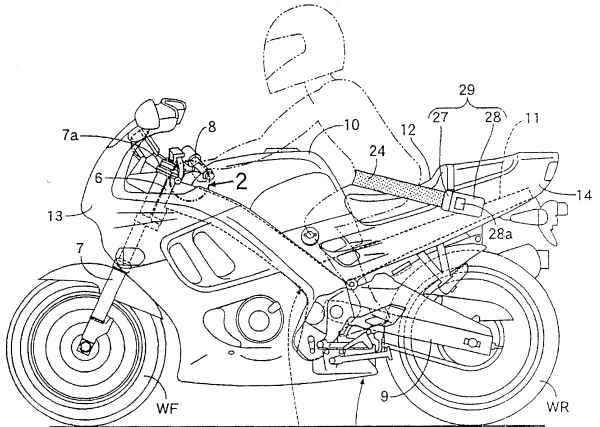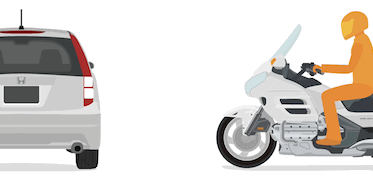
Motorcycle Seatbelts: Everything You Were Too Afraid To Ask
A couple of weeks ago, I was hitching a ride with a cousin of mine in her car. Her four-year-old had just seen me arrive on my motorcycle, and he asked her if bikes have seatbelts. She told him they don't. Then he asked the question that all parents of four-year-olds dread: why. But I thought it's a great question, so I decided to do a little research and write about it.
Motorcycles don’t have seatbelts for the same reason that cars do: it’s safer that way. In the event of a crash, people in a car are safer wearing their seat belts; those on a bike are at greater risk if they’re strapped to their seats. But there are innovations that may change this in the future.
 |
| Patented motorcycle seat belt system. Image: Honda |
If you want to know what you can do to increase your safety as a rider (or passenger) on a motorcycle, even without seatbelts, read on. But first, let’s look at why bikes don’t have seat belts in the first place.
Inertia, or Why Motorcycles Don’t Have Seat Belts
If you remember middle school physics, you may recall the law of inertia. It basically says that if an object is moving at a certain speed and in a particular direction, it will keep on moving at that speed and in that direction, unless an external force tries to stop it.
This is also called Newton’s first law, and you’d have visibly experienced it if you’ve ever tried to step off a moving skateboard -- you end up stumbling along in the same direction in which the skateboard was moving.
Why is this important? Well, because it’s the reason why you need to wear a seat belt in a car. And why you don’t wear one on a motorcycle.
Let’s say a car is driving along at 30 miles per hour when it “T-bones” a truck. The car comes to a sudden stop. Because of the law of inertia, the occupant of the car will still continue to move forward. Without a seat belt to stop them, there’s a high risk of them being thrown out of the vehicle through the windshield, and into the truck -- at 30 miles per hour.

In that scenario, their body ends up absorbing the energy of that impact. As you can imagine, that can lead to serious injury or worse. Instead, if the occupant wore a seat belt, the belt would have stopped them from being hurled out of the vehicle. The energy of the impact would be largely absorbed by the car itself as it crumples under the impact force, protecting the occupant from the worst of the crash.
But while this is true for cars, it’s quite the opposite with motorcycles. You see, because cars have four wheels, they’re fairly stable and tend not to tip over easily (unlike motorcycles). What’s more, in most cars, the passengers are surrounded by the cabin, which is designed to be a relatively safe place to be in, in a crash. Neither of these applies to motorcycles.
As a result, in a motorcycle crash, it’s usually much safer if the rider(s) is not on the motorcycle after the collision. In the T-bone example above, say we replace the car with a motorcycle. Upon collision, the odds are that the motorcycle will fall onto its side as it plows into and under the truck.
If the rider is strapped to the motorcycle, they’d also get pulled along. Instead, if the rider isn’t strapped down, there’s a better chance that as they get thrown off the motorcycle, they decelerate relatively more gradually. In this case, their body absorbs comparatively less of the collision’s impact energy, and they’re relatively safer.
Will Motorcycles of the Future Have Seat Belts?
A while ago, Honda filed a patent for a motorcycle seat belt system. And it might not be just a marketing gimmick either. For context, it’s worth noting that way back in 2005, Honda launched the world’s first airbag system on a production motorcycle, on its Gold Wing model.
It’s quite possible that Honda wants to use the seat belt system on a future version of the Gold, to improve the effectiveness of the Gold Wing’s airbag. Of course, Honda knows fully well that in a motorcycle crash, it’s often better for the rider to be free of the bike than to be attached to it. Their seat belt system, therefore, includes a sensor to monitor if the bike is tipping over, in which case the seat is released from the bike, allowing the rider full and free range of motion.
 |
| Honda Gold Wing airbag animation. Image: Honda |
Only time will tell if or when Honda will eventually launch this feature commercially. But considering the patent was filed over a decade ago, you might not see seat belts on your next motorcycle anytime soon.
How Can You Be Safer, Even Without Seat Belts?
Motorcycles are inherently more risky than cars. According to data from the NHTSA, for every mile traveled, the number of fatalities for motorcycle accidents is 27 times higher than for cars.
That said, I know many motorcyclists who’ve been riding for over a decade, having covered tens of thousands of miles without injury. But they have had “incidents”. In all of their cases, what kept those incidents from turning into something more serious, was the use of good safety practices.
With the application of the following safety practices and a little common sense, you can make a big difference to ensuring that your riding career is safe and accident-free.
1. Always wear a helmet. Regardless of whether the law mandates the use of a motorcycle helmet where you live, it’s a good idea to wear one. Several studies have shown that helmet use significantly lowers the percentage of fatalities and severe brain injuries in motorcycle crashes. And while you’re at it, wear a full-face helmet, please. Open and half helmets just do not offer anywhere nearly the same extent of protection.
2. Wear all the safety gear that you can possibly afford. If you absolutely must prioritize, the helmet comes first at the top of the list, followed by a riding jacket, gloves, riding pants, and riding boots. These things may not seem like a big deal, but a fall at even 10 miles per hour or slower, can be enough to give you a very bad road rash that takes weeks to heal. And even if you don’t have riding boots yet, at least try to wear a pair of sturdy ankle-height boots - flip flops are an absolute no-no.
3. Check your motorcycle before each ride. Do a walkaround to ensure that all the lights and indicators are working, and check your tire pressure. Under- or over-inflated tires do not provide adequate traction in all riding conditions, and bikes with traction control and ABS may not perform optimally if the tire pressures deviate far from the recommended values. And of course, testing the brakes before you go out on a ride is always a great idea.
4. Plan ahead. Checking the weather, traffic, and road conditions for your route can often help you make decisions that help you reach your destination in a better physical and mental state. A tired or stressed-out rider is less safe than a relaxed rider.
5. As far as possible, avoid riding at night time or in bad weather. The risk of getting into an accident increases dramatically when riding in inclement weather or at night. You can have just as much or more fun by rescheduling your ride to a better time, so there’s no benefit to accepting this higher risk without a compelling reason.
6. Improve your self-awareness as a rider. It’s always good to improve your riding skills through practice and instruction, but it’s equally important not to overestimate the extent of your skills. Too many motorcyclists get into crashes simply because they overestimate their ability to control the motorcycle -- trying to enter a corner too fast, or braking too late, for instance.
On a related note, beware of the Peltzman effect. This is a theory that says that you’re likely to be less careful when you perceive less risk. That sounds obvious, but the implication is that as you wear more protective gear, conscientiously check your motorcycle, or train and practice to improve your skills as a rider, there are chances that you become less cautious while riding.
Studies show that exercising such safety measures might lead you to feel much safer than you actually are, and consequently be less cautious while riding. The best way to counter this is to cultivate an attitude to safety that appreciates that accidents could happen at any time, and encourages alertness and safe practices unvaryingly.
I hope this post helps you to be safer around motorcycles, and that it demystified everything to do with seat belts on motorcycles. Ride on, and ride safe!
